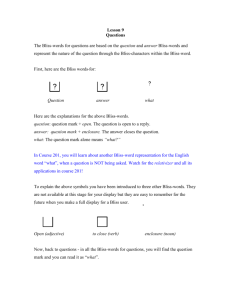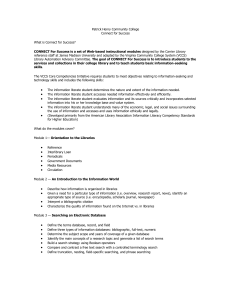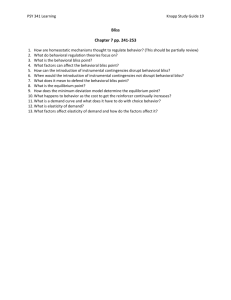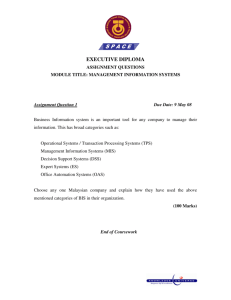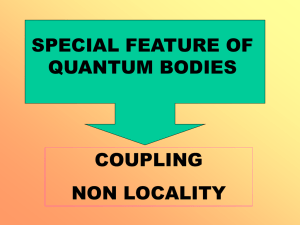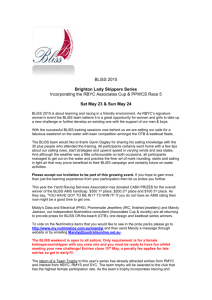Research using published sources
advertisement
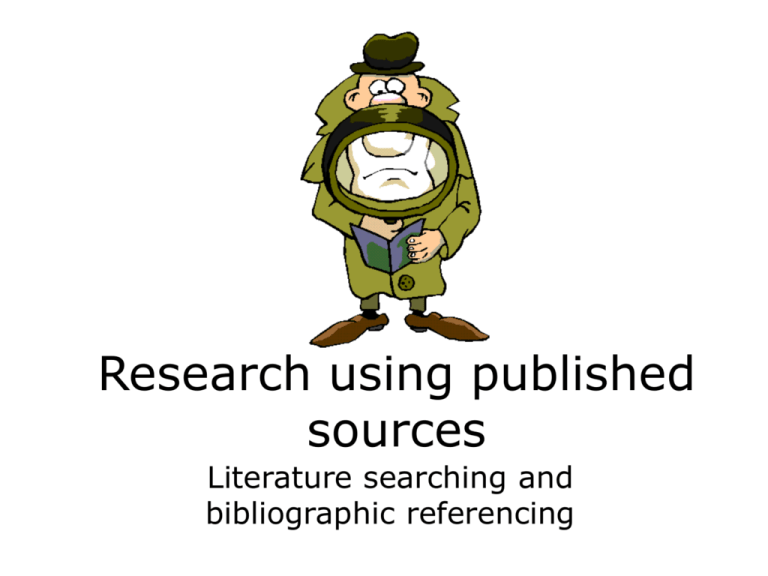
Research using published sources Literature searching and bibliographic referencing Role of secondary sources in research: • Some research will be totally dependent on published materials – historical research – overviews – conceptual studies • most research will require some use of published sources – to provide context – to provide benchmarks – to offer comparison Literature searching for MA/MSc: • Remember the scope of the dissertation – not a doctoral thesis – searching need not be exhaustive • BUT • you should have enough sources: – to properly reflect the state of affairs in your topic – to represent any differing viewpoints – to include all important publications, projects or initiatives Systematic searching: • You will almost certainly need to include: – monographs – journal articles – web based material • you may also need (for example) – theses and conference papers – legislation – statistics Searching for monographs: • Bibliographic databases don’t usually cover books • large library catalogues are a better source • COPAC is a good place to look for book titles • specialist library catalogues may be more extensive in terms of foreign material and non-standard formats Some book databases: • COPAC www.copac.ac.uk – union catalogue of 24 universities + national libraries • British Library www.bl.uk – this and other big libraries have specialised catalogues independent of the main catalogue • Library of Congress www.loc.gov • For foreign language material: – National library catalogues – www.ifla.org Commercial book databases: • Not as comprehensive as catalogues • may be better for new and forthcoming publications • College library has Books in print: • be very wary of e-booksellers sites Searching for journal articles: • The primary source for journal material is the bibliographic database • general databases can provide a good starting point, and enable crossdisciplinary searches • College Library databases often link to full text General periodical databases: • Provide access to journal references • many include conference papers and other formats • zetoc • Web of knowledge • Current contents connect • JStor Specialist LIS databases: • LISA • LISTA • Current awareness abstracts (Library and information management) • H.W.Wilson databases available via the Art Fulltext link on MetaLib • remember print resources for older material • Library literature • hardcopy LISA Subject specialist databases: • The College Library has huge numbers of these • Useful ones may include: • Historical abstracts • INSPEC • Early English books online • ERIC Electronic journals: • Individual journals can be searched • agents’/publishers’ websites can offer cross-domain searching • Swetswise • Taylor and Francis • Ingenta • Emerald fulltext Web-based material: • Managed portals and hubs (RDN www.rdn.ac.uk) • search engines – a quick way to find research publications, reports, government and official publications – use with discretion! – don’t rely on these alone • Good search engines Alltheweb www.alltheweb.com Altavista www.altavista.com Ask Jeeves www.askjeeves.com Google www.google.com Lycos www.lycos.com Hotbot www.hotbot.com Teoma www.teoma.com Profusion www.profusion.com SurfWax www.surfwax.com Vivisimo http://vivisimo.com Kartoo www.kartoo.com Fazzle www.fazzle.com Search tips and hints: • • • • • Don’t make initial searches too complex modify searches in the light of results opt for more obscure keywords remember to search for synonyms not all search software works in the same way • advanced searches usually offer field specific searching and Boolean search • Use results to inform more searches – look for additional keywords – identify important authors or researchers – note key journals • don’t expect to find everything you need at the first attempt • follow up references in articles and use hypertext links Bibliographic referencing How to get it right Bibliographic referencing: • Why reference? • to add authority to your dissertation • to support and reinforce your arguments • to enable readers to follow up the sources themselves • to acknowledge other writers’ work • failing to do this can constitute plagiarism and have legal implications What needs to be referenced? • direct quotations • allusions to content of other works • statements of fact often need to be supported by documentary evidence • this needn’t be taken to extremes in the case of common knowledge What should be included in a reference? • For a book: • • • • • The name(s) of the author(s) the title of the work the place of publication the name of the publisher the date of publication Book reference: Broel, Albert, Frog raising for pleasure and profit. New Orleans, La. : Marlboro House, 1950 Berman, Sanford, The joy of cataloging. Phoenix, AZ : Oryx Press, 1981 Heyl, Barbara S. The madam as entrepreneur : career management in house prostitution. New Brunswick, N.J. : Transaction Books, 1979. Journal references should include: • • • • • • The name(s) of the author(s) the title of the article the title of the journal the date of publication the volume and issue numbers the numbers of the first and last page Journal reference: Trickey, Keith, “From church work with cowgirls to women and the sea and the wider ocean: a random walk through Library of Congress Subject Headings”, Catalogue and index, 2003 No. 147 pp. 7-9 Website references should include: • • • • • The name of the creator of the website the name of the website the url the date of creation (or the last update) the date that you accessed it • some of these may be hard to establish for individual websites, so you may have to omit details Website reference: Lewis, Daphne Dogscooter.com. http://www.dogscooter.com/index.html. Last updated 04/24/2006 02:27:39 (Accessed 07.05.06) Rangwani, Shanti White poison: the horrors of milk. http://www.alternet.org/story.html?StoryID=12002 Posted 3.12.2001 (Accessed 07.05.06) Remember: • Referencing is not cataloguing • you don’t have to include any physical description or other elements • the order and punctuation of elements may differ from standard cataloguing practice Referencing styles: • • • • There are many hundreds of referencing styles they usually differ in minor details SLAIS allows you to use whichever you wish you can follow an established style, or use your own • referencing software such as Reference Manager (Endnote, ProCite, etc.) can do the work for you • the important point is to apply the style consistently Variations in citation styles of different scholarly journals: Adams JQ, Lincoln A, van Buren M, Truman HS: An imaginary conversation. J Hist Fant 76:204-212, 1976 Adams, J. Q.; Lincoln, A.; van Buren, M.; Truman, H. S. An imaginary conversation. Journal of Historical Fantasy 1976 , 76 (11), 204-212. Adams JQ, Lincoln A, van Buren M, Truman HS. An imaginary conversation. J Hist Fant 1976 November 5;76(11):204-12. Adams,J.Q., Lincoln,A., van Buren,M., and Truman,H.S. 1976. An imaginary conversation. Journal of Historical Fantasy 76(11):204-212. ADAMS,J.Q., LINCOLN,A., VAN BUREN,M., TRUMAN,H.S., 1976. "An imaginary conversation", Journal of Historical Fantasy, 76, S. 204-212. Adams JQ, Lincoln A, van Buren M, Truman HS. 1976. An imaginary conversation. Journal of Historical Fantasy 76: 204-212. Basic types of referencing: • There are two main sorts of referencing: • Footnotes/endnotes • Author date systems • numerical systems also occur, but more infrequently Footnotes and endnotes: • These are the same thing, except for their position in the text; footnotes appear on the same page as the reference, endnotes follow on from the text • when you want to make a reference you put a superscript number in the text • the full reference follows an equivalent number at the bottom of the page, or at the end of the piece • Word will do much of this for you • strictly speaking, there is no need for a separate bibliography, but you may like to include one Footnotes: Footnotes: 1 Alan R. Thomas “Bliss classification update” Cataloging & classification quarterly 19(3/4), 1995, 105-17 2 Bliss classification bulletin 37, 1995, 28 3 Clare Sargent “Classifying the undergraduate collection at Queens’ College, Cambridge” Bliss classification bulletin 32, 1990, 10-12 4 Elizabeth Russell and Heather Lane “Working towards an archaeology schedule at the Haddon Library” Bliss classification bulletin 41, 1999, p.17 5 Karen E. Attar “The application of the Bliss Bibliographic Classification in Cambridge College Libraries” New review of academic librarianship 6, 2000, 35-49 6 Heather Lane “Managing organizational change: perspectives on conversion” Bulletin of the Association of British Theological and Philosophical Libraries 6(2), June 1999, 5-10 Footnotes: Author-date systems: • When you want to refer to a source, you put the author’s name, and the date of the publication, plus the page reference, in parentheses, or brackets, in the text • author-date is sometimes called parenthetical referencing • at the end of the text, you provide a list of the references in alphabetical order of authors’ names On a more practical level, a number of libraries adopted BC2 during this period (Thomas, 1995). Of some significance for the development of the classification was its take up by a number of Cambridge libraries, and the formation of a Cambridge Bliss user group, CamBUG, which met for the first time on the 23 March 1995. BC had been used in a small number of Cambridge collections for some years; Fitzwilliam and Queens’ were already using BC2, Queens’ having begun reclassification in 1988 (Sargent, 1990 p.10). The Haddon Library (the Faculty library for Archaeology and Anthropology) used Bliss’s original scheme, but also began to convert to BC2 at an early stage, the anthropology part of the collection being completed in 1988(Russell and Lane, 1999 p.17). The second edition was now to be adopted by more college libraries (Attar, 2000 p.35), including the Sidney Sussex College library,1 and the Quincentenary Library at Jesus Reference list in author-date system Attar, Karen E. (2000), “The application of the Bliss Bibliographic Classification in Cambridge College Libraries”, New review of academic librarianship 6, 35-49 Bliss classification bulletin 37, 1995, 28 Lane, Heather (1999), “Managing organizational change: perspectives on conversion”, Bulletin of the Association of British Theological and Philosophical Libraries 6(2), June, 5-10 Russell, Elizabeth and Lane, Heather (1999), “Working towards an archaeology schedule at the Haddon Library” Bliss classification bulletin 41, p.17 Sargent, Clare (1990), “Classifying the undergraduate collection at Queens’ College, Cambridge”, Bliss classification bulletin 32, 10-12 Thomas, Alan R. (1995), “Bliss classification update”, Cataloging & classification quarterly 19(3/4), 105-17 Author-date versus Footnotes • Is simple and straightforward • suits references to monographs and journal articles • most suitable for references to personal authors • Is better for unauthored works • particularly suitable for mss. and websites • word processor will ‘manage’ the placing and numbering for you Forms of reference: • The form of a reference varies slightly if it is: • a footnote/endnote • a reference in a bibliography • a reference in a list for the author-date system Footnotes: C. H. Peters, Life and love in the aquarium. New York : Empire Tropical Fish Import Co., 1934 William Alan Stuart, Nasal maintenance: nursing your nose through troubled times. New York : McGraw-Hill, 1983 Bibliography: Peters, C. H., Life and love in the aquarium. New York : Empire Tropical Fish Import Co., 1934 Stuart, William Alan, Nasal maintenance: nursing your nose through troubled times. New York : McGraw-Hill, 1983 Reference list (author-date): Peters, C. H. (1934), Life and love in the aquarium. New York : Empire Tropical Fish Import Co. Stuart, William Alan (1983), Nasal maintenance: nursing your nose through troubled times. New York : McGraw-Hill Op. cit., loc. cit., and ibid. • The use of op. cit. (opus citatum/opere citato = the work cited/in the work cited), to mean a work previously referenced, is now generally discouraged • loc. cit. (loco citato = the place cited) is sometimes used if the reference is to the same page in the previously referenced work • ibid. (ibidem = the same) may be used for one or more subsequent references to the same work • none of these should be necessary with author-date systems 1 Fran Slack “Subject searching on OPACs: problems an Vine 83, August 1991, 4-9 1 ibid. p. 5 1 Rodney Brunt “Subject access standards” in Standard future: proceedings of a workshop on the future of b standards. Boston Spa : British Library, 1993 (NBS O publications 2) pp. 23-38 1 ibid. p. 36 Things to remember: • Keep punctuation, including capitalization of initial letters, consistent • Don’t cut and paste from other sources without adjusting the style
